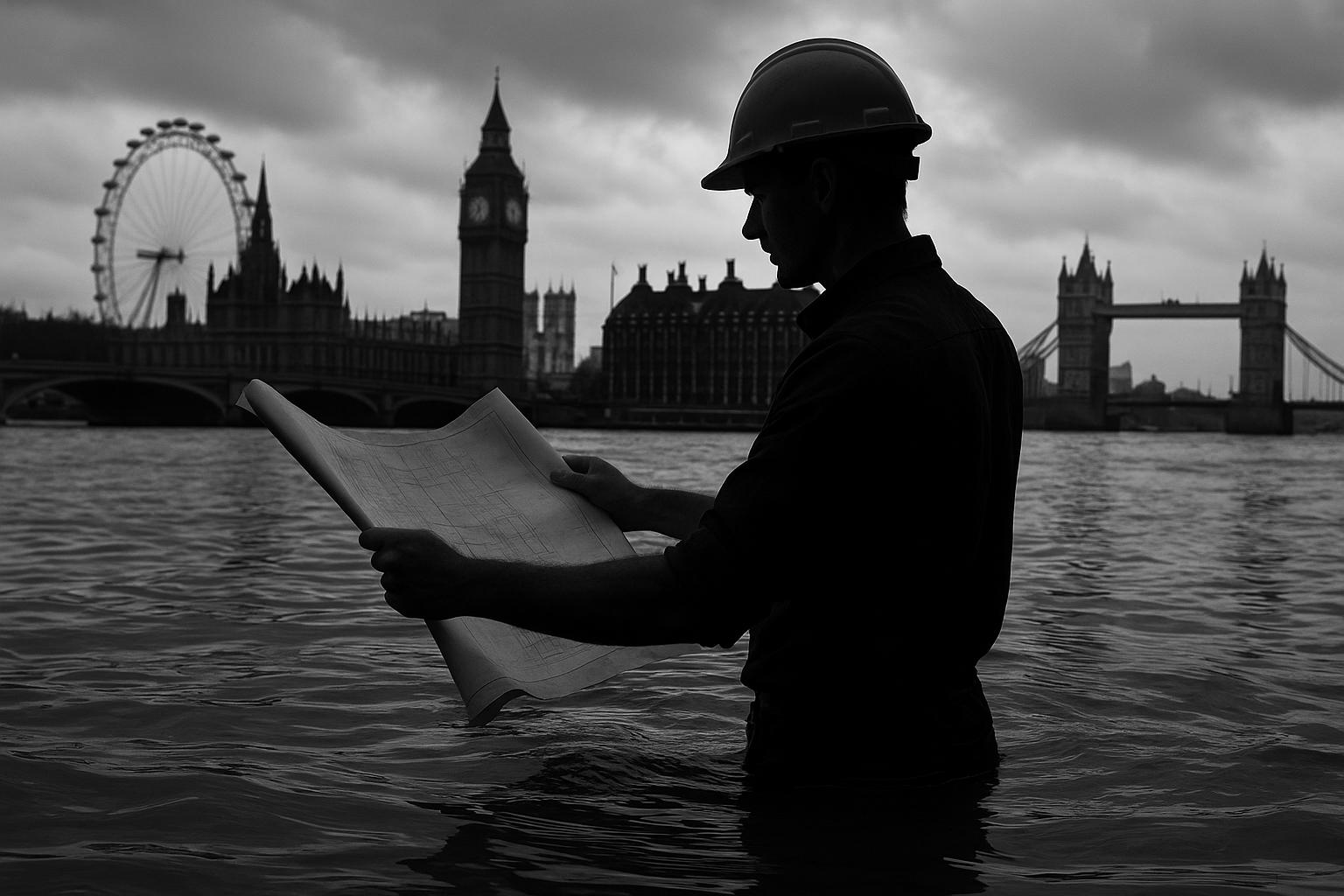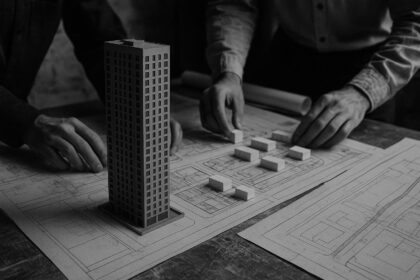As global leaders set new climate targets at COP26, the Institution of Civil Engineers argues the profession must shift from policy debate to tangible delivery — embedding carbon in procurement, designing for heat and flood risks and turning ambition into visible projects across cities such as London.
In the run-up to COP26 in Glasgow, climate change and its consequences have dominated the news agenda, underscoring that the debate is no longer only about policy but also about delivery on the ground. The ICE feature argues that civil engineers must step forward as leaders in this transition, tying practical infrastructure decisions to the broader goals of decarbonisation and resilience. The same week, city authorities warned that London faces mounting flood risk: a quarter of the capital’s rail stations, one in five schools and nearly half of its hospitals could be exposed to surface water flooding in future wetter years, with the city’s underground network at risk of becoming uncomfortably hot for extended periods if temperatures continue to rise. Taken together, these threads illustrate a single point with growing clarity: the time for engineers to act is now, not in some distant future.
The message from the prime minister’s UN address and the accompanying policy frame is stark, and the reference point for civil engineers is practical action, not rhetoric alone. In that speech, described by BBC coverage as a turning point for humanity, leaders were urged to pursue bold climate actions—such as ensuring zero-emission vehicles are on sale by 2040, ending coal power by 2040 in the developing world and 2030 in developed economies, and halting biodiversity loss by 2030—alongside a wider push to accelerate the clean-energy transition and rethink infrastructure investment. The ICE piece links that political urgency to the engineering profession’s remit, framing it through a set of actionable commitments designed to move from discussion to deliverable projects on the ground. At the same time, the ICE briefing on the six ways civil engineers can act on climate change provides a practical playbook: treat this as an emergency, bring carbon into every conversation, understand and influence end users, design and build for the right outcomes, pursue creative solutions, and take responsibility for resilience. The aim is to embed carbon considerations in procurement, fuel broader stakeholder engagement, and accelerate the pace of decarbonisation in the built environment.
Yet the road from aspiration to action is complicated by public pressure and partisan debates about permitting, funding and retrofit. Insulate Britain’s protests on the M25—gluing hands to the road to demand faster action on home insulation and fuel poverty—expose how political and social pressures can intersect with engineering challenges. Court injunctions and heightened public scrutiny have become part of the landscape, while city-level analyses of risk illustrate the scale of the task. In London, for example, the mayoral briefing warns that a substantial portion of critical infrastructure and public services could be exposed to flooding in the coming years, and that heat in the Underground could become an annual, multi-week hazard if adaptation measures lag. Against this backdrop, the ICE’s State of the Nation 2021 work emphasises the need for immediate, tangible progress—the six actions are not a theoretical framework but a call to translate climate ambitions into end-to-end projects that end users can see and benefit from. As the project leader and ICE president has put it in the ongoing Shaping Zero narrative, engineers must answer the question: what are you going to do?
In this context, COP26 appears less a single event and more a catalyst for a sustained shift in professional practice. The conference’s programme—covering finance, energy, nature, transport and the broad architecture of the climate economy—highlights the multi-disciplinary collaboration required to translate policy into project-level outcomes. Schedule highlights and side events emphasise how engineering decisions intersect with finance, regulation and community engagement, underscoring the need for civil engineers to articulate the end-user value of low-carbon design and to collaborate with policymakers and clients to accelerate delivery. For engineers, the path forward is concrete: embed carbon metrics in procurement choices, elevate public and end-user understanding of low-carbon solutions, and design infrastructure that performs under climate stress while supporting social and economic resilience.
In short, the profession faces a dual imperative: accelerate decarbonisation in the built environment while strengthening the resilience of critical infrastructure to climate risks. The evidence from city analyses, protest discourse, and policy discourse converges on a single conclusion. It is not enough to talk about climate action; engineers must lead with practical projects, improvements in planning and procurement, and clear communication with end users. The moment calls for leadership at every level of the supply chain—from the design studio to the operating theatre of public services—so that the ambitions announced at COP26 translate into safer, more sustainable, and better-prepared communities.
 Reference Map:
Reference Map:
Reference Map:
Source: Noah Wire Services
- https://www.ice.org.uk/news-views-insights/inside-infrastructure/why-now-is-the-time-for-civil-engineers-to-act-on-climate-change – Please view link – unable to able to access data
- https://www.bbc.com/news/uk-58657887 – BBC News reports Prime Minister Boris Johnson telling the United Nations that COP26 must be a turning point for humanity, urging fellow leaders to adopt bold climate actions. The address links science-led urgency with market-led solutions, and sets out global commitments: only zero-emission vehicles on sale by 2040; end coal power by 2040 in the developing world and by 2030 in developed economies; and halt and reverse biodiversity loss by 2030. The speech pairs seriousness with humour, including a quip about Kermit the Frog. The piece situates Johnson’s rhetoric within preparations for COP26 in Glasgow and the wider policy debate.
- https://www.bbc.com/news/uk-england-essex-58721909 – BBC News covers Insulate Britain protesters gluing their hands to the M25 during demonstrations and disrupting traffic at junctions, including J30 near Thurrock. Reporting details the arrests of several protesters and the police response, and notes court injunctions banning road obstruction. The piece situates the protests within a broader campaign calling for UK home insulation and faster action on fuel poverty and climate change. It captures public frustration, law enforcement measures, and ongoing civil-disobedience tactics used by the group as part of wider climate activism in late 2021. The article mentions government injunctions curbing disruptive actions and policy tensions today.
- https://www.london.gov.uk/press-releases/mayoral/mayor-warns-londoners-in-basements-about-flooding – London City Hall analysis shows that without urgent action London faces rising flood risk. A citywide briefing indicates that quarter of rail stations, one in five schools and nearly half of London’s hospitals could be exposed to surface water flooding in the future, alongside hundreds of thousands of homes and workplaces. The figures reflect risks from heavy rainfall, river flood events and urban drainage challenges. The briefing underlines the need for resilient infrastructure, better flood planning and adaptation measures as climate impacts intensify. It emphasises the Mayor’s commitment to reducing emissions and pursuing resilience alongside growth across the city region.
- https://www.ice.org.uk/engineering-resources/briefing-sheets/six-ways-for-civil-engineers-to-act-on-climate-change – ICE’s briefing summarises the 2021 State of the Nation report, assessing the UK’s infrastructure carbon footprint and readiness to act on climate change. The document highlights that infrastructure generates a large share of emissions and that the industry must respond with urgency. It sets out six actions for civil engineers: treat this as an emergency; bring carbon into every conversation; understand and influence end users; design and build for the right outcomes; strive for creative solutions; and be responsible for resilience. The piece emphasises collaboration with policymakers, clients and end users to accelerate decarbonisation and climate resilience in practice today.
- https://www.ice.org.uk/news-views-insights/inside-infrastructure/why-now-is-the-time-for-civil-engineers-to-act-on-climate-change – ICE’s feature argues that climate action demands immediate leadership from civil engineers, linking ICE’s SoN to COP26. It notes the urgent need to mainstream low-carbon design, better decision making, and public engagement. The piece quotes the six actions from the SoN and situates them within a broader campaign to accelerate decarbonisation in the built environment. It frames engineers as custodians of infrastructure and climate resilience, urging practitioners to move from talk to action by embedding carbon considerations in procurement, end-user understanding, and resilience planning. The article stresses collaboration with clients and policymakers to translate ambition into practical projects across sectors.
- https://unfccc.int/cop26/schedule – UN Climate Change Conference COP26 schedule page outlines the Glasgow event’s programme, listing thematic days and public engagement alongside negotiation sessions. The schedule confirms COP26’s occurrence in Glasgow in late 2021 and directs participants through finance, energy, youth, nature and transport themes. It emphasises that a blend of political negotiations and side events will shape the ambition and action required to meet the 1.5C target. The page functions as a practical guide to attendees and a snapshot of the conference structure, illustrating how the COP26 process seeks to mobilise finance, technology and policy reform towards a fair, resilient transition globally.
Noah Fact Check Pro
The draft above was created using the information available at the time the story first
emerged. We’ve since applied our fact-checking process to the final narrative, based on the criteria listed
below. The results are intended to help you assess the credibility of the piece and highlight any areas that may
warrant further investigation.
Freshness check
Score:
8
Notes:
Summary: The narrative is time‑bound to the COP26 run‑up and is not a recent rehash of decades‑old material; earliest closely matching publications appear in September–October 2021.  Key timeline: Boris Johnson’s UN speech (22 Sep 2021) was widely published and quoted. ([gov.uk](https://www.gov.uk/government/speeches/pm-speech-at-the-un-general-assembly-22-september-2021?utm_source=chatgpt.com)) Sadiq Khan’s London climate vulnerability analysis and mayoral messaging were published 23 Sep 2021 and contain the rail/station/school/hospital figures cited. ([london.gov.uk](https://www.london.gov.uk/press-releases/mayoral/london-faces-threat-of-soaring-temperatures?utm_source=chatgpt.com)) The ICE feature tying these threads is dated 30 Sep 2021 (ICE blog). ([ice.org.uk](https://www.ice.org.uk/news-views-insights/inside-infrastructure/why-now-is-the-time-for-civil-engineers-to-act-on-climate-change)) ICE’s formal State of the Nation briefing (the six‑point playbook) was published 05 Oct 2021 (briefing sheet). ([ice.org.uk](https://www.ice.org.uk/engineering-resources/briefing-sheets/six-ways-for-civil-engineers-to-act-on-climate-change)) A London City Hall press release with similar risk figures was later updated/republished (29 Jun 2022) — this shows elements of the narrative were reissued/updated after the ICE piece.
Key timeline: Boris Johnson’s UN speech (22 Sep 2021) was widely published and quoted. ([gov.uk](https://www.gov.uk/government/speeches/pm-speech-at-the-un-general-assembly-22-september-2021?utm_source=chatgpt.com)) Sadiq Khan’s London climate vulnerability analysis and mayoral messaging were published 23 Sep 2021 and contain the rail/station/school/hospital figures cited. ([london.gov.uk](https://www.london.gov.uk/press-releases/mayoral/london-faces-threat-of-soaring-temperatures?utm_source=chatgpt.com)) The ICE feature tying these threads is dated 30 Sep 2021 (ICE blog). ([ice.org.uk](https://www.ice.org.uk/news-views-insights/inside-infrastructure/why-now-is-the-time-for-civil-engineers-to-act-on-climate-change)) ICE’s formal State of the Nation briefing (the six‑point playbook) was published 05 Oct 2021 (briefing sheet). ([ice.org.uk](https://www.ice.org.uk/engineering-resources/briefing-sheets/six-ways-for-civil-engineers-to-act-on-climate-change)) A London City Hall press release with similar risk figures was later updated/republished (29 Jun 2022) — this shows elements of the narrative were reissued/updated after the ICE piece.  ([london.gov.uk](https://www.london.gov.uk/press-releases/mayoral/mayor-warns-londoners-in-basements-about-flooding)) Assessment notes: • No evidence the ICE narrative is lifted from anonymous clickbait networks; coverage originates with established organisations (ICE, City Hall, BBC, UN).
([london.gov.uk](https://www.london.gov.uk/press-releases/mayoral/mayor-warns-londoners-in-basements-about-flooding)) Assessment notes: • No evidence the ICE narrative is lifted from anonymous clickbait networks; coverage originates with established organisations (ICE, City Hall, BBC, UN).  • Several components (PM speech, mayoral analysis, Insulate Britain protests) predate the ICE blog by days–weeks (so not ‘brand new’ in isolation) — but the ICE piece packages them into a profession‑facing call to action.
• Several components (PM speech, mayoral analysis, Insulate Britain protests) predate the ICE blog by days–weeks (so not ‘brand new’ in isolation) — but the ICE piece packages them into a profession‑facing call to action.  ([bbc.com](https://www.bbc.com/news/uk-england-essex-58721909?utm_source=chatgpt.com), [gov.uk](https://www.gov.uk/government/speeches/pm-speech-at-the-un-general-assembly-22-september-2021?utm_source=chatgpt.com)) • If the editor’s main concern is pure novelty, flag: parts of the narrative (PM/Guterres quotes, mayoral figures, protest reports) had earlier publication dates (>7 days earlier) and are reused here.
([bbc.com](https://www.bbc.com/news/uk-england-essex-58721909?utm_source=chatgpt.com), [gov.uk](https://www.gov.uk/government/speeches/pm-speech-at-the-un-general-assembly-22-september-2021?utm_source=chatgpt.com)) • If the editor’s main concern is pure novelty, flag: parts of the narrative (PM/Guterres quotes, mayoral figures, protest reports) had earlier publication dates (>7 days earlier) and are reused here.
Quotes check
Score:
5
Notes:
Summary: Several direct quotations in the narrative are reused from public speeches and reporting rather than being exclusive to the ICE piece.  Examples: • Boris Johnson’s line calling COP26 a “turning point for humanity” and his Kermit reference originate in his UN speech (22 Sep 2021) and were published by BBC/GOV.UK. ([gov.uk](https://www.gov.uk/government/speeches/pm-speech-at-the-un-general-assembly-22-september-2021?utm_source=chatgpt.com), [bbc.com](https://www.bbc.com/news/uk-58657887?utm_source=chatgpt.com)) • António Guterres’ warning about being “weeks away…light‑years away” from targets appears in UN remarks and press coverage ahead of COP26. ([un.org](https://www.un.org/sg/en/content/sg/speeches/2021-09-30/remarks-pre-cop26?utm_source=chatgpt.com), [washingtonpost.com](https://www.washingtonpost.com/climate-environment/2021/10/25/antonio-guterres-climate-change/?utm_source=chatgpt.com)) • Insulate Britain protest wording (gluing to the M25) is widely reported (BBC coverage 30 Sep 2021). ([bbc.com](https://www.bbc.com/news/uk-england-essex-58721909?utm_source=chatgpt.com)) • ICE’s own institutional phrasing (e.g. the six actions and the ICE President’s challenge “what are you going to do?”) appears in ICE material and may be original or organisation‑specific. ([ice.org.uk](https://www.ice.org.uk/engineering-resources/briefing-sheets/six-ways-for-civil-engineers-to-act-on-climate-change)) Assessment notes: • Identical wording for the high‑profile political quotes is found in earlier official transcripts/reports — flag as reused rather than exclusive. • Where the narrative quotes ICE leadership or internal materials, these are plausibly original or internal to ICE; treat those as institutionally sourced rather than independent exclusives.
Examples: • Boris Johnson’s line calling COP26 a “turning point for humanity” and his Kermit reference originate in his UN speech (22 Sep 2021) and were published by BBC/GOV.UK. ([gov.uk](https://www.gov.uk/government/speeches/pm-speech-at-the-un-general-assembly-22-september-2021?utm_source=chatgpt.com), [bbc.com](https://www.bbc.com/news/uk-58657887?utm_source=chatgpt.com)) • António Guterres’ warning about being “weeks away…light‑years away” from targets appears in UN remarks and press coverage ahead of COP26. ([un.org](https://www.un.org/sg/en/content/sg/speeches/2021-09-30/remarks-pre-cop26?utm_source=chatgpt.com), [washingtonpost.com](https://www.washingtonpost.com/climate-environment/2021/10/25/antonio-guterres-climate-change/?utm_source=chatgpt.com)) • Insulate Britain protest wording (gluing to the M25) is widely reported (BBC coverage 30 Sep 2021). ([bbc.com](https://www.bbc.com/news/uk-england-essex-58721909?utm_source=chatgpt.com)) • ICE’s own institutional phrasing (e.g. the six actions and the ICE President’s challenge “what are you going to do?”) appears in ICE material and may be original or organisation‑specific. ([ice.org.uk](https://www.ice.org.uk/engineering-resources/briefing-sheets/six-ways-for-civil-engineers-to-act-on-climate-change)) Assessment notes: • Identical wording for the high‑profile political quotes is found in earlier official transcripts/reports — flag as reused rather than exclusive. • Where the narrative quotes ICE leadership or internal materials, these are plausibly original or internal to ICE; treat those as institutionally sourced rather than independent exclusives. 
Source reliability
Score:
9
Notes:
Summary: The narrative draws on reputable, verifiable organisations and official statements — a strength.  Evidence: • The main piece is published by the Institution of Civil Engineers (ICE) (30 Sep 2021). ([ice.org.uk](https://www.ice.org.uk/news-views-insights/inside-infrastructure/why-now-is-the-time-for-civil-engineers-to-act-on-climate-change)) • ICE’s State of the Nation briefing (05 Oct 2021) is an ICE publication and is available as a briefing sheet. ([ice.org.uk](https://www.ice.org.uk/engineering-resources/briefing-sheets/six-ways-for-civil-engineers-to-act-on-climate-change)) • Political/policy claims cite recognised outlets and official texts (GOV.UK / Boris Johnson speech; UN statements; London City Hall analysis). ([gov.uk](https://www.gov.uk/government/speeches/pm-speech-at-the-un-general-assembly-22-september-2021?utm_source=chatgpt.com), [un.org](https://www.un.org/sg/en/content/sg/speeches/2021-09-30/remarks-pre-cop26?utm_source=chatgpt.com), [london.gov.uk](https://www.london.gov.uk/press-releases/mayoral/london-faces-threat-of-soaring-temperatures?utm_source=chatgpt.com)) • Reporting of protest action (Insulate Britain) is corroborated by mainstream coverage (BBC, Guardian). ([bbc.com](https://www.bbc.com/news/uk-england-essex-58721909?utm_source=chatgpt.com), [theguardian.com](https://www.theguardian.com/uk-news/2021/sep/29/insulate-britain-activists-block-m25-by-glueing-themselves-to-road?utm_source=chatgpt.com)) Assessment notes: • Because much of the narrative is driven by ICE’s own briefing and commentary (i.e. institution‑led communications), readers should note it is advocacy from a professional body rather than independent investigative journalism — not a reliability failure, but a framing factor.
Evidence: • The main piece is published by the Institution of Civil Engineers (ICE) (30 Sep 2021). ([ice.org.uk](https://www.ice.org.uk/news-views-insights/inside-infrastructure/why-now-is-the-time-for-civil-engineers-to-act-on-climate-change)) • ICE’s State of the Nation briefing (05 Oct 2021) is an ICE publication and is available as a briefing sheet. ([ice.org.uk](https://www.ice.org.uk/engineering-resources/briefing-sheets/six-ways-for-civil-engineers-to-act-on-climate-change)) • Political/policy claims cite recognised outlets and official texts (GOV.UK / Boris Johnson speech; UN statements; London City Hall analysis). ([gov.uk](https://www.gov.uk/government/speeches/pm-speech-at-the-un-general-assembly-22-september-2021?utm_source=chatgpt.com), [un.org](https://www.un.org/sg/en/content/sg/speeches/2021-09-30/remarks-pre-cop26?utm_source=chatgpt.com), [london.gov.uk](https://www.london.gov.uk/press-releases/mayoral/london-faces-threat-of-soaring-temperatures?utm_source=chatgpt.com)) • Reporting of protest action (Insulate Britain) is corroborated by mainstream coverage (BBC, Guardian). ([bbc.com](https://www.bbc.com/news/uk-england-essex-58721909?utm_source=chatgpt.com), [theguardian.com](https://www.theguardian.com/uk-news/2021/sep/29/insulate-britain-activists-block-m25-by-glueing-themselves-to-road?utm_source=chatgpt.com)) Assessment notes: • Because much of the narrative is driven by ICE’s own briefing and commentary (i.e. institution‑led communications), readers should note it is advocacy from a professional body rather than independent investigative journalism — not a reliability failure, but a framing factor.  • No indication that the named persons or organisations are fabricated — all are verifiable.
• No indication that the named persons or organisations are fabricated — all are verifiable. 
Plausability check
Score:
8
Notes:
Summary: Core factual claims are plausible and corroborated, but some are projections or scenario‑dependent and should be read as modelled risk rather than deterministic outcomes.  Evidence and checks: • The London vulnerability numbers (quarter of rail stations, one in five schools, nearly half of hospitals at risk) are present in City Hall analysis and contemporaneous reporting. ([london.gov.uk](https://www.london.gov.uk/press-releases/mayoral/london-faces-threat-of-soaring-temperatures?utm_source=chatgpt.com), [theguardian.com](https://www.theguardian.com/uk-news/2021/sep/23/climate-crisis-fifth-london-schools-susceptible-flooding-sadiq-khan?utm_source=chatgpt.com)) • The PM and UN quotes signalling urgency are documented in official speeches and are correctly attributed. ([gov.uk](https://www.gov.uk/government/speeches/pm-speech-at-the-un-general-assembly-22-september-2021?utm_source=chatgpt.com), [un.org](https://www.un.org/sg/en/content/sg/speeches/2021-09-30/remarks-pre-cop26?utm_source=chatgpt.com)) • The reference to Insulate Britain protests and legal injunctions is supported by BBC/Guardian reporting. ([bbc.com](https://www.bbc.com/news/uk-england-essex-58721909?utm_source=chatgpt.com), [theguardian.com](https://www.theguardian.com/uk-news/2021/sep/29/insulate-britain-activists-block-m25-by-glueing-themselves-to-road?utm_source=chatgpt.com)) • Technical plausibility: peer‑reviewed and expert material (e.g. studies on Underground heat risk and asset vulnerability) show the Underground faces growing heat‑related operational risks — the claim that the Tube could become ‘unbearably hot’ for extended periods is consistent with research and TfL reporting. ([rmets.onlinelibrary.wiley.com](https://rmets.onlinelibrary.wiley.com/doi/full/10.1002/wea.4421?utm_source=chatgpt.com), [wsj.com](https://www.wsj.com/world/the-london-tube-feels-like-hell-efforts-to-cool-it-just-make-it-hotter-35b7a94a?utm_source=chatgpt.com)) Caveats / flags: • Many of the ‘risk’ figures are scenario‑based projections (depend on climate scenarios and time horizons). Flag for editors: ensure the narrative distinguishes observed impacts from modelled future exposure.
Evidence and checks: • The London vulnerability numbers (quarter of rail stations, one in five schools, nearly half of hospitals at risk) are present in City Hall analysis and contemporaneous reporting. ([london.gov.uk](https://www.london.gov.uk/press-releases/mayoral/london-faces-threat-of-soaring-temperatures?utm_source=chatgpt.com), [theguardian.com](https://www.theguardian.com/uk-news/2021/sep/23/climate-crisis-fifth-london-schools-susceptible-flooding-sadiq-khan?utm_source=chatgpt.com)) • The PM and UN quotes signalling urgency are documented in official speeches and are correctly attributed. ([gov.uk](https://www.gov.uk/government/speeches/pm-speech-at-the-un-general-assembly-22-september-2021?utm_source=chatgpt.com), [un.org](https://www.un.org/sg/en/content/sg/speeches/2021-09-30/remarks-pre-cop26?utm_source=chatgpt.com)) • The reference to Insulate Britain protests and legal injunctions is supported by BBC/Guardian reporting. ([bbc.com](https://www.bbc.com/news/uk-england-essex-58721909?utm_source=chatgpt.com), [theguardian.com](https://www.theguardian.com/uk-news/2021/sep/29/insulate-britain-activists-block-m25-by-glueing-themselves-to-road?utm_source=chatgpt.com)) • Technical plausibility: peer‑reviewed and expert material (e.g. studies on Underground heat risk and asset vulnerability) show the Underground faces growing heat‑related operational risks — the claim that the Tube could become ‘unbearably hot’ for extended periods is consistent with research and TfL reporting. ([rmets.onlinelibrary.wiley.com](https://rmets.onlinelibrary.wiley.com/doi/full/10.1002/wea.4421?utm_source=chatgpt.com), [wsj.com](https://www.wsj.com/world/the-london-tube-feels-like-hell-efforts-to-cool-it-just-make-it-hotter-35b7a94a?utm_source=chatgpt.com)) Caveats / flags: • Many of the ‘risk’ figures are scenario‑based projections (depend on climate scenarios and time horizons). Flag for editors: ensure the narrative distinguishes observed impacts from modelled future exposure.  • Tone is mostly professional/advocacy rather than sensational, but occasional dramatic phrasing (e.g. “turning point for humanity”) is political rhetoric reused from speeches — check for conflation of rhetoric and empirical claim. 🛈
• Tone is mostly professional/advocacy rather than sensational, but occasional dramatic phrasing (e.g. “turning point for humanity”) is political rhetoric reused from speeches — check for conflation of rhetoric and empirical claim. 🛈
Overall assessment
Verdict (FAIL, OPEN, PASS): PASS
Confidence (LOW, MEDIUM, HIGH): HIGH
Summary:
Conclusion: The narrative is credible and based on verifiable, reputable inputs (ICE material, mayoral analysis, PM and UN speeches, mainstream reporting).  Primary risks: recycled public quotes and policy messaging (reused from official speeches) and reliance on institution‑led briefing (ICE) rather than independent investigation — these are transparency/novelty concerns rather than disinformation.
Primary risks: recycled public quotes and policy messaging (reused from official speeches) and reliance on institution‑led briefing (ICE) rather than independent investigation — these are transparency/novelty concerns rather than disinformation.  Corroboration: The ICE blog (30 Sep 2021) and ICE State of the Nation briefing (05 Oct 2021) are the publication origins for the professional call‑to‑action; mayoral vulnerability figures and PM/UN quotes predate or coincide with the ICE piece and are published by City Hall, GOV.UK and UN transcripts. ([ice.org.uk](https://www.ice.org.uk/news-views-insights/inside-infrastructure/why-now-is-the-time-for-civil-engineers-to-act-on-climate-change), [london.gov.uk](https://www.london.gov.uk/press-releases/mayoral/london-faces-threat-of-soaring-temperatures?utm_source=chatgpt.com), [gov.uk](https://www.gov.uk/government/speeches/pm-speech-at-the-un-general-assembly-22-september-2021?utm_source=chatgpt.com), [un.org](https://www.un.org/sg/en/content/sg/speeches/2021-09-30/remarks-pre-cop26?utm_source=chatgpt.com)) Recommended editorial guidance: 1) Mark the political/public quotes as quoted from official speeches (not ICE originals).
Corroboration: The ICE blog (30 Sep 2021) and ICE State of the Nation briefing (05 Oct 2021) are the publication origins for the professional call‑to‑action; mayoral vulnerability figures and PM/UN quotes predate or coincide with the ICE piece and are published by City Hall, GOV.UK and UN transcripts. ([ice.org.uk](https://www.ice.org.uk/news-views-insights/inside-infrastructure/why-now-is-the-time-for-civil-engineers-to-act-on-climate-change), [london.gov.uk](https://www.london.gov.uk/press-releases/mayoral/london-faces-threat-of-soaring-temperatures?utm_source=chatgpt.com), [gov.uk](https://www.gov.uk/government/speeches/pm-speech-at-the-un-general-assembly-22-september-2021?utm_source=chatgpt.com), [un.org](https://www.un.org/sg/en/content/sg/speeches/2021-09-30/remarks-pre-cop26?utm_source=chatgpt.com)) Recommended editorial guidance: 1) Mark the political/public quotes as quoted from official speeches (not ICE originals).  2) Note which claims are modelled projections (scenario‑dependent) and add explicit time horizons or model references where possible.
2) Note which claims are modelled projections (scenario‑dependent) and add explicit time horizons or model references where possible.  3) If freshness/novelty is essential, flag that several component items (PM speech, mayoral analysis, Insulate Britain protests) were published days–weeks earlier and were repackaged by ICE into a profession‑facing call to action.
3) If freshness/novelty is essential, flag that several component items (PM speech, mayoral analysis, Insulate Britain protests) were published days–weeks earlier and were repackaged by ICE into a profession‑facing call to action.  Overall judgement: reliable, properly attributed reporting with routine reuse of public quotes and institutional advocacy — acceptable to publish with the clarifications above.
Overall judgement: reliable, properly attributed reporting with routine reuse of public quotes and institutional advocacy — acceptable to publish with the clarifications above. 













